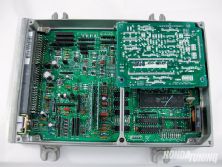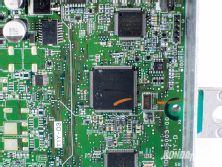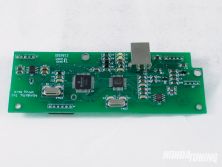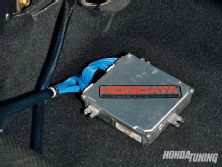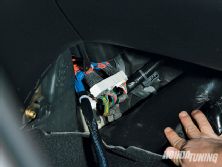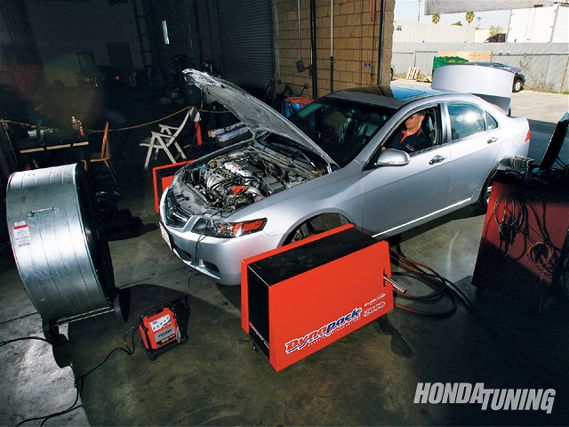 | Hondata K-Pro ECU - Wrenchin'
| Hondata K-Pro ECU - Wrenchin'
Hondata's Dual Adapter Harness
If a car's engine is its heart, then its ECU is no doubt its brain. Honda's done an excellent job building highly efficient, easy-to-tune, small-displacement engines. From its B-series to its K-series, extracting power via bolt on parts isn't terribly difficult. But since the introduction of OBD-2-based electronics, fuel injection tuning in hopes of maximizing power and efficiency has become that much more challenging. And with the introduction of CAN-based (controller area network) ECUs, it's become next to impossible, especially if you don't have the wherewithal to re-write OEM parameters. Fortunately, Hondata has the wherewithal. The company has been tweaking and modifying OEM-based Honda electronics since the late 1990s, giving tuners the capability to tune ECUs in ways that were previously possibly only with standalone systems. Both Hondata's S300 and K-Pro systems rely on OEM Honda electronics and algorithms but offer tuners complete control over things like fuel injector pulse width and ignition timing.
Whether they liked it or not, Hondata's engineers have been forced to focus their efforts on the drive-by-wire family of Honda ECUs. Until recently, there were few, but today such electronic throttle technology's become industry-standard. As such, systems like Hondata's K-Pro were limited to cable-based throttle engines like the RSX and pre-'06 Civics. But now, with the addition of a specially made jumper harness and a PRB-based ECU, K-Pro is now compatible with virtually any TSX or S2000.
Drive By Wire Killed It
The fact that newer ECUs utilize drive-by-wire technology isn't why they're so difficult to crack. Indeed, the problem has nothing to do with the electronic throttle but with the electronic architecture that just so happens to be paired with it. Despite how sophisticated these modern ECUs are, they cannot be touched. Honda's ECU manufacturer, Keihin, has implemented circuitry with increased processing power and trim capabilities. This allows the computer to keep emissions low by constantly adjusting fuel and ignition parameters. Such ECUs take into account lean or rich conditions and engine knock and make adjustments as necessary; they can even adjust long-term fuel injection characteristics for a more precise burn. As conditions change-like when you tweak with your engine- these newer ECUs are even more likely to throw a fit and trip a Check Engine light than their older counterparts were. As such, tuners looking to make significant changes have been forced to look to standalone systems. Until now.
To Standalone Or Not
The key behind Hondata's approach is that it's based off of OEM circuitry and electronics but gives tuners the control they need, not unlike what you'd find with a standalone system. Many ROM tuners-those who prefer to reprogram the factory circuitry as opposed to standalone systems- find comfort in the millions of dollars the manufacturer spent developing the ECU, while tuners who prefer standalone systems argue that such tuning gives them the flexibility to tune past what the factory sensors are capable of. Hondata's K-Pro and S300 systems incorporate the flexibility of a standalone and the factory engineering of an OEM unit into a single system. It uses its proprietary firmware to offer features like data logging, boost protection, and nitrous control, but its limitations include a loss of cruise control functions, limited data supply through its OBD-2 port, and an inability to fine-tune traction control or throttle characteristics. But nothing's perfect, and the only way you're going to get features like these is by stepping up to a high-dollar standalone.
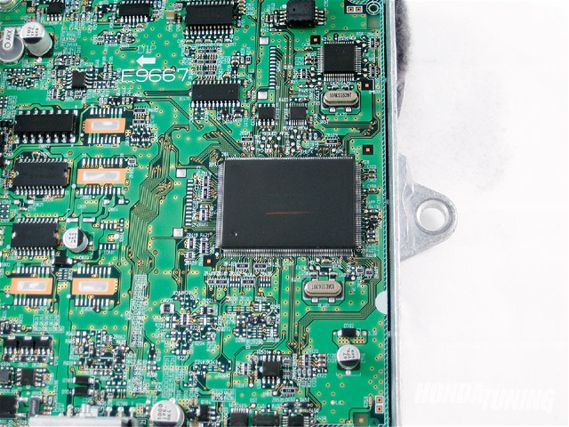 | 2007-and-newer TSXs feature CAN-based OBD-2 electronics. With an increased demand for processing power, Honda ECU manufacturer Keihin switched processor manufacturers from OKI Semiconductors to Hitachi.
| 2007-and-newer TSXs feature CAN-based OBD-2 electronics. With an increased demand for processing power, Honda ECU manufacturer Keihin switched processor manufacturers from OKI Semiconductors to Hitachi.
The K-Pro Standard
When Hondata first began developing its K-Pro system, its engineers soon realized that PRB and older P30 ECUs' internal programming structures were similar. Unfortunately, this isn't the case for newer TSX and S2000 ECUs, as ECU manufacturer Keihin opted for an entirely different internal processor. Although both processors are manufactured by the same company, their programming structures are completely different. And once Honda switched from conventional OBD electronics to CAN-based ECUs, it switched to a RISC-type processor manufactured by Hitachi. As such, Hondata was forced to either develop an entirely new tuning system from scratch or find a way to make the K-Pro work.
But What About A Re-Flash?
But why can't these newer ECUs simply be re-flashed? The question is often asked, and it makes sense since the EVO and Subaru guys are doing it. Why can't we? We can, but it's simply cost-prohibitive. Of course, Honda has the ability to re-flash its own firmware, but the equipment is difficult to obtain and extremely expensive. And permanently damaging a Honda ECU due to a brief power failure during the re-flash process is a very expensive likelihood that Hondata simply isn't interested in dealing with.
Making Power
But how does Hondata's Dual Adapter Harness K-Pro perform on a vehicle otherwise not destined for a K-Pro, like the drive-by-wire TSX? Simply put, it performs like any other K-Pro would, drive-by-wire or not. The standard controls are all there: VTEC adjustment, fuel enrichment, and ignition timing. But more importantly, Hondata's K-Pro allows for camshaft timing adjustments well past the TSX's 20-degree limitation. The K24's intake VTC gear must be machined or an RSX unit can be swapped in place first though. The results are increased valve overlap, which is important when searching for more power in naturally aspirated situations. It's important to not tune past 45 degrees of camshaft advance, however, as piston-to-valve conflicts can occur at such aggressive settings on K24 engines.
As for numbers, Hondata's demo TSX, which featues a Hondata-modified camshaft pulley, a Hytech header and exhaust system, a high-flow catalytic converter, an Injen intake, and, of course, the company's K-Pro system, laid down an extra 16.2 lb-ft of torque and 20 peak hp with no more than a simple ECU addition-that's nearly 40 lb-ft of torque more than a stock TSX when you consider the bolt-ons. The gains are likely attributed to the increased overlap, which the TSX appreciates even more considering its free-flowing intake and exhaust systems. To be fair though, the TSX shines more on the street than it does on the dyno. The torque bump is obvious here, especially during situations where the unmodified ECU would otherwise create low-rpm lagging and slower throttle response. But at wide-open throttle, the party begins. Despite the TSX's refined, semi-luxurious interior, it's simply impossible to ignore the 237 hp that's now underneath the hood. Impossible.

